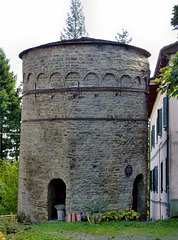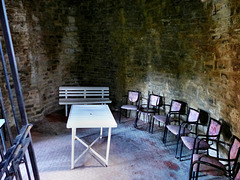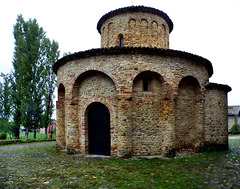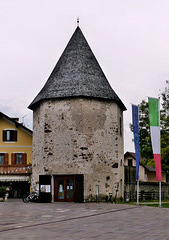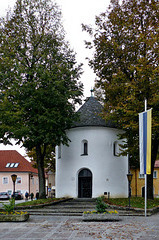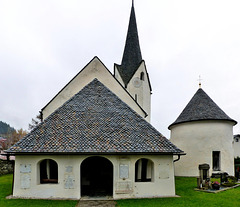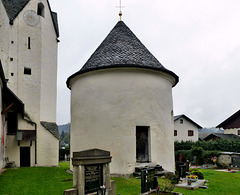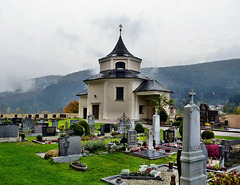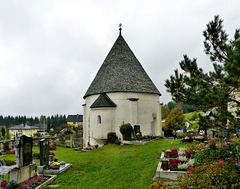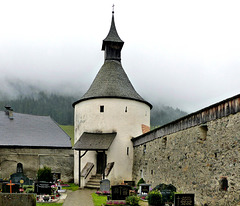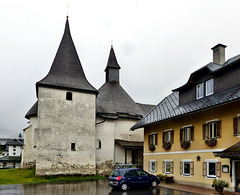
Round Churches
Round buildings/structures have been used as temples in very early times. In Early Christianity round buildings were used as churches, chapels, baptisteries or ossuaries
Lizzano in Belvedere - San Mamante
| |
|
|
Behind the pretty new Neo-Byzantine parish church (see previous uploads) stands this round building, erected by Lombards after in 751 King Aistulf had conquered the Exarchate of Ravenna and so ended the Byzantine influence here. This rotunda, named "delubro", was erected mid 8th century, when the area had been transferred to the Nonantola Abbey.
It is claimed locally, that this is the most ancient stone monument in the whole Province of Bologna. It was probably used as a baptistery first. In the 12th century it was used as the base of the bell tower - and remained so upto 1951, when the old tower was demolished.
The rotunda is not exactly round, but has an elliptical floorplan (4,40 m x 3,85 m). There are two doors.
Lizzano in Belvedere - San Mamante
| |
|
|
Just behind the pretty new Neo-Byzantine parish church (see previous upload), hidden in the shadow of the (as well new) campanile stands this round building, erected by Lombards after in 751 King Aistulf had conquered the Exarchate of Ravenna and so ended the Byzantine influence here. This rotunda, named "delubro", was erected mid 8th century, when the area had been transferred to the Nonantola Abbey.
It is claimed locally, that this is the most ancient stone monument in the whole Province of Bologna. It was probably used as a baptistery first. In the 12th century it was used as the base of the bell tower - and remained so upto 1951, when the old tower was demolished.
The rotunda is not exactly round, but has an elliptical floorplan (4,40 m x 3,85 m).
Lizzano in Belvedere - San Mamante
| |
|
Behind the pretty new Neo-Byzantine parish church (see previous uploads) stands this round building, erected by Lombards after in 751 King Aistulf had conquered the Exarchate of Ravenna and so ended the Byzantine influence here. This rotunda, named "delubro", was erected mid 8th century, when the area had been transferred to the Nonantola Abbey.
It is claimed locally, that this is the most ancient stone monument in the whole Province of Bologna. It was probably used as a baptistery first. In the 12th century it was used as the base of the bell tower - and remained so upto 1951, when the old tower was demolished.
The rotunda is not exactly round, but has an elliptical floorplan (4,40 m x 3,85 m). The door was open... The building has a small apse, where the white bench is.
It looks like a little gazebo, where neighbours meet in the evening to have a chat and a glass of wine.
Vigolo Marchese - San Giovanni
| |
|
|
Vigolo Marchese, a village with a population of about 400 and today a part of Castell'Arquato, must have been of some importance in medieval times. Here is a large Romanesque church - and a baptistery, built in the early 11th century. Documents prove that in 1008 a Benedictine convent was founded here, funded by Oberto, Marchese d´Orta, who even had the relics of Saint Hippolyt transfered to the church.
A baptistery next to a convent´s church is very unusual. Some scholars claim it may be older than the church. It may have been built on the foundation of a Roman temple and used as an oratory by the monks, before it was transformed into a baptistery. It obviously withstood the earthquake from 1117.
A local tradition tells, that the building was erected by a Knight Templar returning from Jerusalem. Knight Templars indeed erected many circular churches throughout Europe on the model of the Church of the Holy Sepulchre, but the order, endorsed by Rome around 1129 is younger than the baptistery.
Unfortunately the baptistery is only open on sundays.
Tarvisio - Santi Pietro e Paolo
| |
|
The parish church of Tarvisio (German "Tarvis"), dedicated to Peter and Paulus was built within the 15th century. The round octagonal "Karner" (= ossuary) may date from the 13th century, when a second round tower existed here as well. Tarvisio is located on an old, important Trans-Alpine road, only about 8kms south of the border between Italy and Austria. It belonged from 1002 to 1759 to the Prince-Bishopric of Bamberg (= "Hochstift Bamberg).
In medieval times Bamberg (about 600kms north) was the center of a very powerful diocese. When in 1238 Berthold V. von Andechs became Patriarch of Aquileia and moved the capital of the ecclesiastical state from Cividale to Udine (see previous uploads), his uncle Poppo von Andechs-Meranien was Bishop in Bamberg.
When the church was built, it was strongly fortified, surrounded by walls and ditches, as the area was raided by Turkish troops from 1478 on.
Tarvisio - Santi Pietro e Paolo
| |
|
The parish church of Tarvisio (German "Tarvis") was built within the 15th century. The round octagonal "Karner" (= ossuary) next to it may date from the 13th century, when a second round tower existed here as well. The church was strongly fortified, surrounded by walls and ditches, as the area was raided by Turkish troops from 1478 on. The tower, later used as a "karner" or "mausoleum", was in the beginning built for defense. Karners do not need loop holes.
Tarvisio is located on an old, important Trans-Alpine road, only about 8kms south of the border between Italy and Austria. It belonged from 1002 to 1759 to the Prince-Bishopric of Bamberg (= "Hochstift Bamberg).
In medieval times Bamberg (about 600kms north) was the center of a very powerful diocese. When in 1238 Berthold V. von Andechs became Patriarch of Aquileia and moved the capital of the ecclesiastical state from Cividale to Udine (see previous uploads), his uncle Poppo von Andechs-Meranien was Bishop in Bamberg.
Feldkirchen - Maria im Dorn
| |
|
A church may have been here already in 888, when the place was mentioned as "Veldchiricha" by Arnulf of Carinthia. Arnulf, after having overthrown his uncle Charles III (aka "Charles the Fat"), became the Carolingian king of East Francia, later King of Italy and for two years Holy Roman Emperor.
It in known, that the "House of Eppenstein", had a proprietary church here around 1065. The erection of the church seen today started in 1166, after the place got integrated into the diocese of Bamberg.
The Romanesque basilica and the tower got then altered in Gothic times, when an additonal nave was added - and the basilica got a new roof, now covering nave and side aisles. After the incursion of the Turkish troops in 1478, the church got fortified, what did not help much, when Hungarian troops ("Schwarze Armee") raided the area only 4 years later.
The round karner (ossuary), seen here, has two storeys and was built in the 12th century.
Sankt Veit an der Glan - Sankt Veit
| |
|
|
The parish church is mentioned first time in 1131, then belonging to the Diocese of Gurk, but in 1137 the place was "acquired" by the Diocese of Bamberg, like so many places and villages in Carinthia.
The once Romanesque building burned down in 1829 and got rebuilt within the 19th century.
The round karner (ossuary), next to the church, erected within the 12th or 13th century survived the fire.
Glantschach - Sankt Andreas
| |
|
|
The church and the round Karner (ossuary), surrounded by the graveyard, are located right in the center of the little village (pop >400). The first church was erected here between 958 and 991 and so is one of oldest in the area. Some walls of this building may still exist and be part of the church seen today. The large nathex is of course younger.
The round Karner is dated to the 12th century.
Glantschach - Sankt Andreas
| |
|
The church and the round Karner (ossuary), surrounded by the graveyard, are located right in the center of the little village (pop > 400). The first church was erected here between 958 and 991 and so is one of oldest in the area. Some walls of this building may still exist and be part of the church seen today.
The round Karner is dated to the 12th century.
Gurk - Dom
| |
|
In 1043 Hemma of Gurk (canonized in 1938) founded the Benedictine double monastery of Gurk Abbey, where she withdrew during the last years of her life.
After Saint Hemma´s death, the abbey was dissolved by the Archbishop of Salzburg, who instead set up the Diocese of Gurk-Klagenfurt in 1072.
The "Gurk Cathedral" is a large Romanesque basilica, built 1140 - 1220. The crypt got consecrated already in 1174 and since then hosts the grave of Saint Hemma of Gurk, still a place of pilgrimage.
The graveyard of the Cathedral has two round chapels. This newer one follows the architecture of the traditional Karners (ossuaries), may have been used as funeral hall.
Gurk - Dom
| |
|
In 1043 Hemma of Gurk (canonized in 1938) founded the Benedictine double monastery of Gurk Abbey, where she withdrew during the last years of her life.
After Saint Hemma´s death, the abbey was dissolved by the Archbishop of Salzburg, who instead set up the Diocese of Gurk-Klagenfurt in 1072.
The "Gurk Cathedral" is a large Romanesque basilica, built 1140 - 1220. The crypt got consecrated already in 1174 and since then hosts the grave of Saint Hemma of Gurk, still a place of pilgrimage.
The graveyard of the Cathedral has two round chapels. Here is the older one, that may have been used as a Karner (ossuary).
Pisweg - St. Lambert
| |
|
St. Lambert, parish church of the village of Pisweg, today a part of Gurk, was mentioned the first time in 1164. As the church of today was Romanesque and got altered into a Gothic church later, it may well be, that it did exist already within the 12th century.
The round Karner (ossuary) is dated to the 13th century
Pisweg - St. Lambert
| |
|
St. Lambert, parish church of the village of Pisweg, today a part of Gurk, was mentioned the first time in 1164.
The round Karner (ossuary), next to the church, is dated to the 13th century. Now used as a war memorial it is known for the frescoes under the dome.
Straßburg - Hl. Geist
| |
|
Gerold of Friesach founded a hospital for the poor just west of Straßburg in 1337, when he was Bishop of Gurk. The round early-Gothic church may have been part of this infirmary already then, it was mentioned the first time in 1407.
The church got enlarged and altered later. Unfortunately it was locked.
Glödnitz - Hl. Margaretha
| |
|
|
Hemma of Gurk had a chapel here, mentioned in 1043. This was dedicated to Saint Michael. The parish church of today, probably erected, where the chapel once was, is dedicated to St. Margaretha, a popular saint in the area.
End of the 15th century, in the time of the Turkish incursions, the church got heavily fortified. Still today it is surrounded by a massive wall, that once had a defensive corridor. The round Karner (ossuary) has loopholes.
Glödnitz - Hl. Margaretha
| |
|
|
|
Hemma of Gurk had a chapel here, mentioned in 1043. This was dedicated to Saint Michael. The parish church of today, probably erected, where the chapel once was, is dedicated to St. Margaretha, a popular saint in the area.
End of the 15th century, in the time of the Turkish incursions, the church got heavily fortified. Still today it is surrounded by a massive wall, that once had a defensive corridor. The round Karner (ossuary) has arrow slits.
Flattnitz - Hl. Johannes der Täufer
| |
|
The church in Flattnitz, dedicated to Saint John the Baptist, belongs to the parish of Glödnitz. It is located on the Flattnitz Pass, that may have been used already in Roman times.
Arnulf of Carinthia, an illegitimate son of Carloman, who became Carolingian king of East Francia after having overthrown his uncle Charles III (aka "Charles the Fat"), (and later even for two years Holy Roman Emperor), tranferred the ownership of Flattnitz to one supporters in 898. At that time silver and lead were extracted here.
Later it belonged to the Diocese of Gurk and Bischop Heinrich I had a round church erected here, that he consecrated in 1173. Within the next two centuries an "hospitium" was added and the church got altered and fortified. This did not keep the Turkish troops away, who sacked the area in 1478.
Unfortunately the church was locked. Even the restaurant (right) was closed.
Jump to top
RSS feed- Latest items - Subscribe to the latest items added to this album
- ipernity © 2007-2024
- Help & Contact
|
Club news
|
About ipernity
|
History |
ipernity Club & Prices |
Guide of good conduct
Donate | Group guidelines | Privacy policy | Terms of use | Statutes | In memoria -
Facebook
Twitter

